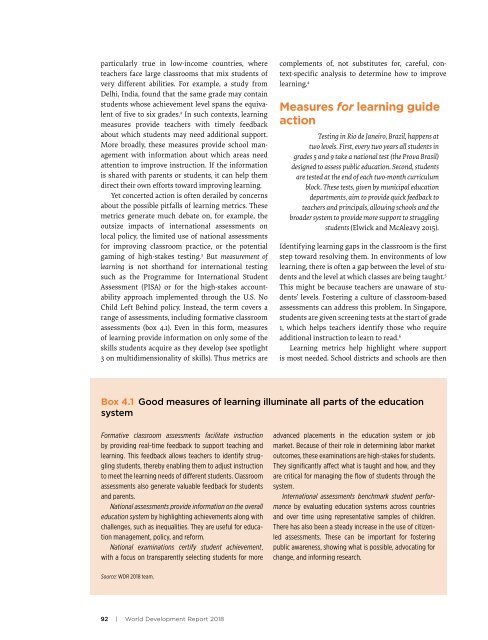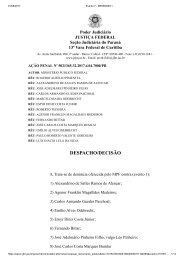Brasil só deve dominar Leitura em 260 anos, aponta estudo do Banco Mundial Relatorio Banco Mundial _Learning
Create successful ePaper yourself
Turn your PDF publications into a flip-book with our unique Google optimized e-Paper software.
particularly true in low-income countries, where<br />
teachers face large classrooms that mix students of<br />
very different abilities. For example, a study from<br />
Delhi, India, found that the same grade may contain<br />
students whose achiev<strong>em</strong>ent level spans the equivalent<br />
of five to six grades. 2 In such contexts, learning<br />
measures provide teachers with timely feedback<br />
about which students may need additional support.<br />
More broadly, these measures provide school manag<strong>em</strong>ent<br />
with information about which areas need<br />
attention to improve instruction. If the information<br />
is shared with parents or students, it can help th<strong>em</strong><br />
direct their own efforts toward improving learning.<br />
Yet concerted action is often derailed by concerns<br />
about the possible pitfalls of learning metrics. These<br />
metrics generate much debate on, for example, the<br />
outsize impacts of international assessments on<br />
local policy, the limited use of national assessments<br />
for improving classroom practice, or the potential<br />
gaming of high-stakes testing. 3 But measur<strong>em</strong>ent of<br />
learning is not shorthand for international testing<br />
such as the Programme for International Student<br />
Assessment (PISA) or for the high-stakes accountability<br />
approach impl<strong>em</strong>ented through the U.S. No<br />
Child Left Behind policy. Instead, the term covers a<br />
range of assessments, including formative classroom<br />
assessments (box 4.1). Even in this form, measures<br />
of learning provide information on only some of the<br />
skills students acquire as they <strong>deve</strong>lop (see spotlight<br />
3 on multidimensionality of skills). Thus metrics are<br />
compl<strong>em</strong>ents of, not substitutes for, careful, context-specific<br />
analysis to determine how to improve<br />
learning. 4<br />
Measures for learning guide<br />
action<br />
Testing in Rio de Janeiro, Brazil, happens at<br />
two levels. First, every two years all students in<br />
grades 5 and 9 take a national test (the Prova <strong>Brasil</strong>)<br />
designed to assess public education. Second, students<br />
are tested at the end of each two-month curriculum<br />
block. These tests, given by municipal education<br />
departments, aim to provide quick feedback to<br />
teachers and principals, allowing schools and the<br />
broader syst<strong>em</strong> to provide more support to struggling<br />
students (Elwick and McAleavy 2015).<br />
Identifying learning gaps in the classroom is the first<br />
step toward resolving th<strong>em</strong>. In environments of low<br />
learning, there is often a gap between the level of students<br />
and the level at which classes are being taught. 5<br />
This might be because teachers are unaware of students’<br />
levels. Fostering a culture of classroom-based<br />
assessments can address this probl<strong>em</strong>. In Singapore,<br />
students are given screening tests at the start of grade<br />
1, which helps teachers identify those who require<br />
additional instruction to learn to read. 6<br />
<strong>Learning</strong> metrics help highlight where support<br />
is most needed. School districts and schools are then<br />
Box 4.1 Goodmeasuresoflearningilluminateallpartsoftheeducation<br />
syst<strong>em</strong><br />
Formative classroom assessments facilitate instruction<br />
by providing real-time feedback to support teaching and<br />
learning. This feedback allows teachers to identify struggling<br />
students, thereby enabling th<strong>em</strong> to adjust instruction<br />
to meet the learning needs of different students. Classroom<br />
assessments also generate valuable feedback for students<br />
and parents.<br />
National assessments provide information on the overall<br />
education syst<strong>em</strong> by highlighting achiev<strong>em</strong>ents along with<br />
challenges, such as inequalities. They are useful for education<br />
manag<strong>em</strong>ent, policy, and reform.<br />
National examinations certify student achiev<strong>em</strong>ent,<br />
with a focus on transparently selecting students for more<br />
advanced plac<strong>em</strong>ents in the education syst<strong>em</strong> or job<br />
market. Because of their role in determining labor market<br />
outcomes, these examinations are high-stakes for students.<br />
They significantly affect what is taught and how, and they<br />
are critical for managing the flow of students through the<br />
syst<strong>em</strong>.<br />
International assessments benchmark student performance<br />
by evaluating education syst<strong>em</strong>s across countries<br />
and over time using representative samples of children.<br />
There has also been a steady increase in the use of citizenled<br />
assessments. These can be important for fostering<br />
public awareness, showing what is possible, advocating for<br />
change, and informing research.<br />
Source: WDR 2018 team.<br />
92 | World Development Report 2018








